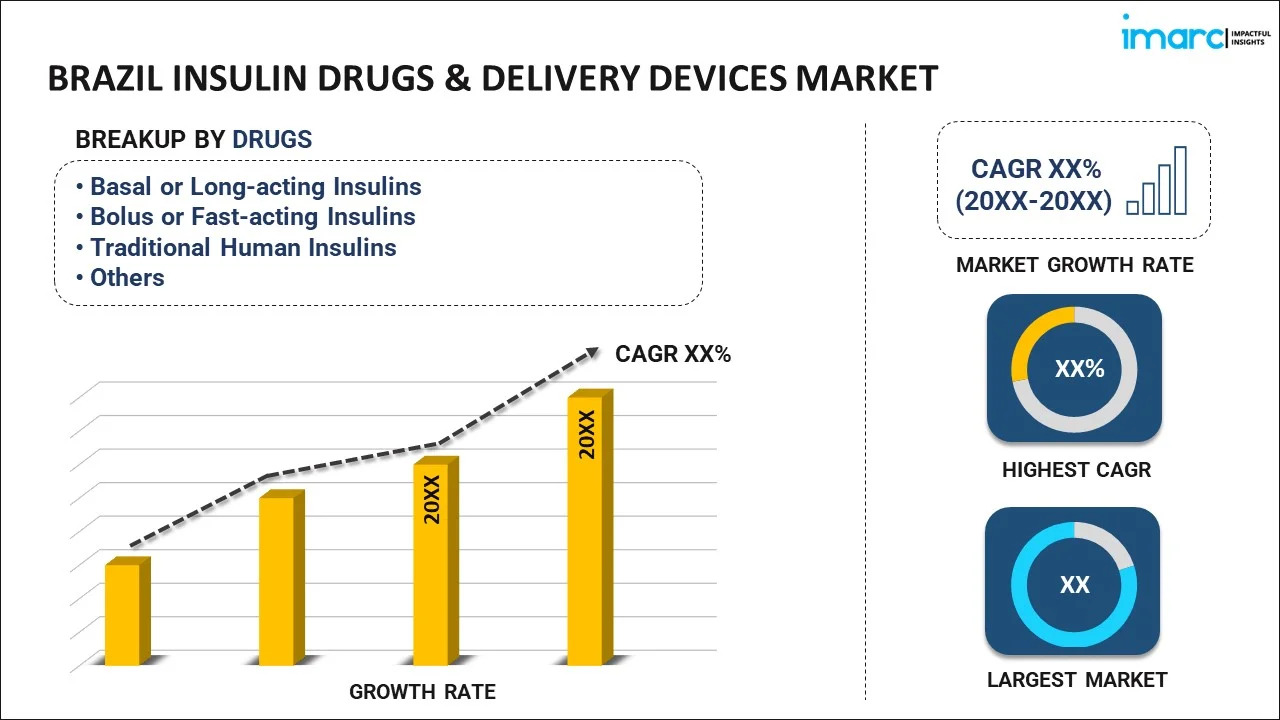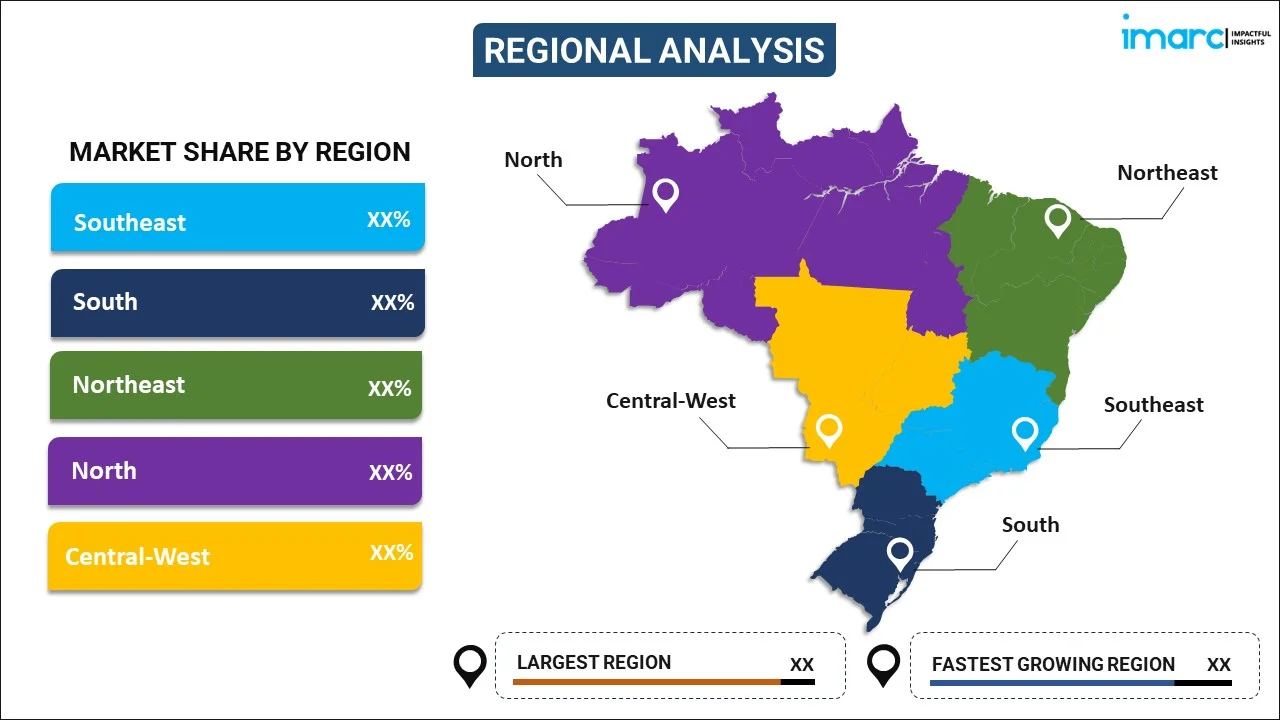
Brazil Insulin Drugs & Delivery Devices Market Report by Drug (Basal or Long-acting Insulins, Bolus or Fast-acting Insulins, Traditional Human Insulins, Combination Insulins, Biosimilar Insulins), Device (Insulin Pens, Insulin Pumps, Insulin Syringes, Insulin Jet Injectors), and Region 2026-2034
Market Overview:
Brazil insulin drugs & delivery devices market size reached USD 949.4 Million in 2025. Looking forward, IMARC Group expects the market to reach USD 1,033.7 Million by 2034. The rising prevalence of diabetes, improvements in healthcare infrastructure, regulatory approvals and funding for advanced delivery devices, expanding geriatric population base, advancements in technology, and increased awareness about diabetes management represent some of the key factors driving the market.
|
Report Attribute
|
Key Statistics
|
|---|---|
|
Base Year
|
2025
|
|
Forecast Years
|
2026-2034
|
|
Historical Years
|
2020-2025
|
|
Market Size in 2025
|
USD 949.4 Million |
|
Market Forecast in 2034
|
USD 1,033.7 Million |
Insulin drugs & delivery devices form an integral part of diabetes management, a condition characterized by high blood sugar levels due to insufficient insulin production or action. Insulin drugs are bioactive substances designed to regulate glucose levels in the blood. They come in multiple forms, such as rapid-acting, long-acting, and intermediate-acting insulins, each serving specific therapeutic needs. These drugs work by facilitating the uptake of glucose into cells, thereby lowering elevated blood sugar levels. Delivery devices are the mechanisms used to administer these insulin drugs into the body. Traditional syringes were the earliest forms of such devices, but advances in medical technology have led to a variety of more convenient and accurate delivery options. Insulin pens, for instance, offer pre-filled or refillable options and are easier to carry and use. Insulin pumps provide a continuous supply of insulin, closely mimicking the natural secretion of the hormone by the pancreas. Some newer devices even come with integrated glucose monitoring systems, allowing for real-time adjustment of insulin doses.
Brazil Insulin Drugs & Delivery Devices Market Trends:
The increase in the number of diabetes cases represents one of the key factors driving the growth of the market across Brazil. This is primarily attributed to changing lifestyles, including poor diet and a lack of physical activity, which is driving the demand for insulin drugs and delivery devices. Improvements in healthcare infrastructure, including better diagnostic facilities, are making it easier to diagnose and manage diabetes, which is increasing the usage of insulin products. The market is also driven by the government's role in promoting public health, subsidizing healthcare, and improving access to medication. Regulatory approvals and funding for advanced delivery devices are further bolstering the market. In addition to this, advancements in technology are leading to more efficient and user-friendly insulin delivery devices, such as smart insulin pens and insulin pumps. These innovations drive consumer interest and acceptance. The entrance of generic versions of insulin drugs is making treatment more affordable for a larger segment of the population. Likewise, an extended distribution network ensures that these drugs and devices are accessible even in remote areas. In line with this, the increasing awareness about diabetes management through educational campaigns and digital platforms is leading more people to seek proper treatment, which is influencing the demand for insulin products. Apart from this, insurance coverage and reimbursement policies that cover the cost of insulin drugs and delivery devices are significantly impacting the market growth by making these treatments more accessible to the average consumer. Moreover, the presence of both local and global players fosters competition and keeps prices in check. Companies are increasingly focusing on research and development (R&D) to develop new products, which is creating a positive outlook for the market across the country.
Brazil Insulin Drugs & Delivery Devices Market Segmentation:
IMARC Group provides an analysis of the key trends in each segment of the market, along with forecasts at the country level for 2026-2034. Our report has categorized the market based on drug and device.
Drug Insights:

- Basal or Long-acting Insulins
- Lantus (Insulin Glargine)
- Levemir (Insulin Detemir)
- Toujeo (Insulin Glargine)
- Tresiba (Insulin Degludec)
- Basaglar (Insulin Glargine)
- Bolus or Fast-acting Insulins
- NovoRapid/Novolog (Insulin aspart)
- Humalog (Insulin lispro)
- Apidra (Insulin glulisine)
- FIASP (Insulin aspart)
- Admelog (Insulin lispro Sanofi)
- Traditional Human Insulins
- Novolin/Mixtard/Actrapid/Insulatard
- Humulin
- Insuman
- Combination Insulins
- NovoMix (Biphasic Insulin aspart)
- Ryzodeg (Insulin degludec and Insulin aspart)
- Xultophy (Insulin degludec and Liraglutide)
- Soliqua/Suliqua (Insulin glargine and Lixisenatide)
- Biosimilar Insulins
- Insulin Glargine Biosimilars
- Human Insulin Biosimilars
The report has provided a detailed breakup and analysis of the market based on the drug. This includes basal or long-acting insulins {lantus (insulin glargine), levemir (insulin detemir), toujeo (insulin glargine), tresiba (insulin degludec), and basaglar (insulin glargine)}, bolus or fast-acting insulins {(novorapid/novolog (insulin aspart), humalog (insulin lispro), apidra (insulin glulisine), FIASP (insulin aspart), and admelog (insulin lispro sanofi)}, traditional human insulins {(novolin/mixtard/actrapid/insulatard, humulin, and insuman)}, combination insulins {(novomix (biphasic insulin aspart), ryzodeg (insulin degludec and insulin aspart), xultophy (insulin degludec and liraglutide), and soliqua/suliqua (insulin glargine and lixisenatide)}, and biosimilar insulins {(insulin glargine biosimilars and human insulin biosimilars)}.
Device Insights:
- Insulin Pens
- Cartridges in Reusable Pens
- Disposable Insulin Pens
- Insulin Pumps
- Insulin Pump Devices
- Insulin Pump Reservoirs
- Insulin Infusion Sets
- Insulin Syringes
- Insulin Jet Injectors
A detailed breakup and analysis of the market based on the device have also been provided in the report. This includes insulin pens (cartridges in reusable pens and disposable insulin pens), insulin pumps (insulin pump devices, insulin pump reservoirs and insulin infusion sets), insulin syringes, and insulin jet injectors.
Regional Insights:

- Southeast
- South
- Northeast
- North
- Central-West
The report has also provided a comprehensive analysis of all the major regional markets, which include Southeast, South, Northeast, North, and Central-West.
Competitive Landscape:
The market research report has also provided a comprehensive analysis of the competitive landscape in the market. Competitive analysis such as market structure, key player positioning, top winning strategies, competitive dashboard, and company evaluation quadrant has been covered in the report. Also, detailed profiles of all major companies have been provided.
Brazil Insulin Drugs & Delivery Devices Market Report Coverage:
| Report Features | Details |
|---|---|
| Base Year of the Analysis | 2025 |
| Historical Period | 2020-2025 |
| Forecast Period | 2026-2034 |
| Units | Million USD |
| Scope of the Report | Exploration of Historical and Forecast Trends, Industry Catalysts and Challenges, Segment-Wise Historical and Predictive Market Assessment:
|
| Drugs Covered |
|
| Devices Covered |
|
| Regions Covered | Southeast, South, Northeast, North, Central-West |
| Customization Scope | 10% Free Customization |
| Post-Sale Analyst Support | 10-12 Weeks |
| Delivery Format | PDF and Excel through Email (We can also provide the editable version of the report in PPT/Word format on special request) |
Key Questions Answered in This Report:
- How has the Brazil insulin drugs & delivery devices market performed so far and how will it perform in the coming years?
- What is the breakup of the Brazil insulin drugs & delivery devices market on the basis of drug?
- What is the breakup of the Brazil insulin drugs & delivery devices market on the basis of device?
- What are the various stages in the value chain of the Brazil insulin drugs & delivery devices market?
- What are the key driving factors and challenges in the Brazil insulin drugs & delivery devices?
- What is the structure of the Brazil insulin drugs & delivery devices market and who are the key players?
- What is the degree of competition in the Brazil insulin drugs & delivery devices market?
Key Benefits for Stakeholders:
- IMARC’s industry report offers a comprehensive quantitative analysis of various market segments, historical and current market trends, market forecasts, and dynamics of the Brazil insulin drugs & delivery devices market from 2020-2034.
- The research report provides the latest information on the market drivers, challenges, and opportunities in the Brazil insulin drugs & delivery devices market.
- Porter's five forces analysis assist stakeholders in assessing the impact of new entrants, competitive rivalry, supplier power, buyer power, and the threat of substitution. It helps stakeholders to analyze the level of competition within the Brazil insulin drugs & delivery devices industry and its attractiveness.
- Competitive landscape allows stakeholders to understand their competitive environment and provides an insight into the current positions of key players in the market.
Need more help?
- Speak to our experienced analysts for insights on the current market scenarios.
- Include additional segments and countries to customize the report as per your requirement.
- Gain an unparalleled competitive advantage in your domain by understanding how to utilize the report and positively impacting your operations and revenue.
- For further assistance, please connect with our analysts.
 Request Customization
Request Customization
 Speak to an Analyst
Speak to an Analyst
 Request Brochure
Request Brochure
 Inquire Before Buying
Inquire Before Buying




.webp)




.webp)












